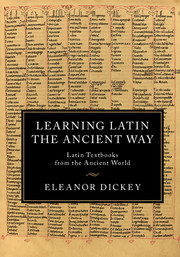3 - Grammatical works
Published online by Cambridge University Press: 05 March 2016
Summary
Ancient grammatical works were always written in the language being discussed, regardless of their intended audience: grammars of Greek were composed in Greek and grammars of Latin in Latin, even when they were intended to be used by language learners. This rule applied not only to grammars proper, that is to explanatory works in continuous prose, but also to paradigm tables, whose headings and labels were always in Latin if the paradigms themselves were Latin. This convention persisted through the Middle Ages and into the early modern period; our idea that one language can be effectively explained in another language is a relatively recent one.
This language barrier naturally made grammatical texts difficult for beginners to use. That fact, coupled with the relatively small number of surviving grammatical papyri compared to other surviving language-learning papyri, has led some scholars to believe that grammatical instruction was not a part of elementary language learning at all and that formal language analysis was introduced only at a comparatively advanced level. There is, however, considerable counter-evidence to this view. The schoolbook sections of the colloquia, which describe children in the process of language learning, frequently mention grammatical instruction. Some grammatical materials survive in transliteration (e.g. passage 7.2), suggesting that they were used even by learners who had not yet invested the time needed to learn the Roman alphabet. The way that Dositheus translated his grammar (see below) indicates that he intended it to be used by students at the very beginning of their Latin studies. And the rarity of Latin grammatical papyri may be illusory, not a feature of what has actually survived but a feature of what has been published. Sets of paradigms are, for good reason, relatively far down the priority list of most papyrological collections, and recent investigations have revealed a number of unpublished and partially published Latin grammatical papyri.
It is therefore likely that ancient Latin students used grammatical materials early in their studies: how exactly did they do that, if the materials were entirely in Latin? A theoretical possibility is a sort of “immersion course” conducted entirely in Latin, but this can be ruled out on the basis of the large number of translated texts evidently used by beginners: clearly elementary students operated primarily in Greek during their Latin classes.
- Type
- Chapter
- Information
- Learning Latin the Ancient WayLatin Textbooks from the Ancient World, pp. 82 - 99Publisher: Cambridge University PressPrint publication year: 2016



